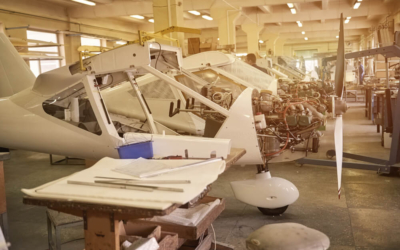As technology evolves, so too does manufacturing within the aerospace sector. These technologies are catalyzing advancements in test solutions, board electronics, mechanical systems, IoT, AR applications, and more in aerospace manufacturing. The introduction of 3D printing in aerospace has also enabled more efficient creation of complex and customized components, significantly impacting cost and weight parameters. This technological convergence is not just redefining processes but also reimagining the future of the aerospace industry.
Blog
Aerospace and Defense
Aerospace Manufacturing: How Today’s Innovations Will Help Us Go Farther
Aerospace and Defense, All Content, Digital Manufacturing
The aerospace and defense industry experienced a notable economic recovery in 2022, driven by the growing demand for air travel. As passenger traffic returns to pre-pandemic levels, there has been an increase in orders for new aircraft and military equipment, indicating ongoing growth in the coming year. Now is a great time to look ahead and determine which aerospace manufacturing innovations are likely to affect space exploration in the next decades.
How Is Electrification Shaping the Aerospace and Defense Market?
Aerospace and Defense, All Content, Energy
The aerospace and defense industry is increasingly embracing electrification as a key trend, driven by the need to reduce carbon emissions, improve efficiency, and develop new technologies. In this article, we will explore the various facets of electrification in aerospace and defense, including its benefits, challenges, and the latest developments in the market.
Global Standards: Ensuring Quality in Aerospace Manufacturing
Aerospace and Defense, All Content, Digital Manufacturing
In the highly competitive field of aerospace manufacturing, quality and consistency are paramount. To achieve these goals, companies must adhere to international standards that set the bar for excellence. International standards provide a common framework for...
Testing Aerospace Components and Systems
Aerospace and Defense, All Content
Few industries bear as much responsibility as the aerospace industry. Hundreds of lives are at stake every time an aircraft takes off. Therefore, aerospace manufacturing companies must be held to high standards to ensure that any aircraft built with their components has the lowest risk possible. Testing your parts is an essential part of this process. Consider how international standards and modern equipment can help you test better.
Unique Materials Used in Aerospace Manufacturing
Aerospace and Defense, All Content, Digital Manufacturing
The aerospace industry is consistently at the forefront of materials science. Aerospace manufacturing companies must be constantly ready to adopt new materials and produce them to satisfy the demands of major players in the industry. What are some of the new types of materials that we can expect to find in upcoming aircraft?
Future of Radio Tech: Latest Trends in Software-Defined Radios
Aerospace and Defense, All Content, Research
The world of radio technology is rapidly changing: in recent years, software-defined radios (SDRs) have been gaining popularity due to their flexibility and versatility. These radios use software to define their functionality instead of traditional hardware components, allowing for greater adaptability and customization. As we continue to move towards a more connected world, SDRs have become a critical part of modern communication systems, as they have evolved at a significantly rapid pace in recent years, with new and innovative developments being introduced on a regular basis, making the SDR market a rich and captivating space
Digital Transformation Trends That Will Change the Aerospace Industry
Aerospace and Defense, All Content
The rapid pace of change in the aerospace industry is largely fueled by digital transformation. Many of the current key digital transformation trends are improving workflow, training, and the way data analytics are used.
Safe Flight: The Importance of Aerospace Manufacturing Testing
Aerospace and Defense, All Content, Digital Manufacturing
Aerospace manufacturing is one of the most complex processes, given the incredibly high importance of aircraft reliability. A crash can cripple a company. Boeing’s woes with the 737-MAX severely hampered their growth and limited orders, for example, and those issues could have been avoided with more careful testing and better solutions to issues. With renewed emphasis on safety, aircraft manufacturers expect their suppliers to uphold a higher standard. How can you make your business a better partner for aircraft manufacturing?
Whitepaper: How Using a Test Executive Prevents Reactive Development
Aerospace and Defense, All Content
As devices become more complex, test teams are under increased pressure to get products to market faster, making an optimized test strategy more important than ever. Test engineers have the difficult task of building the tester for the subsequent product while maintaining previous testers.
What Are the Main Components of an ATE System
Aerospace and Defense, All Content, Digital Manufacturing, Research
The aerospace industry relies on Automated Test Equipment (ATE) systems to enhance testing efficiency, accuracy, and reliability. These systems are an integral part of modern electronics manufacturing, as they help reduce the time and effort required to test each device while providing valuable insights into the manufacturing process.
Aero & Defense: Digital Transformation Tech Enablers
Aerospace and Defense, All Content
Another industrial revolution is in progress. This time, it’s Industry 4.0. Companies around the world are working hard to complete their digital transformation and take advantage of the opportunities that Industry 4.0 has to offer. Nowhere is this more important than in the aerospace and defense industries, where large, lucrative contracts come with big expectations. To stay ahead of the competition, you’ll need as many tech enablers as possible to adopt a fully digital environment.
Tech enablers are the underlying technologies and tools that make a greater technological achievement possible. The steam engine was a tech enabler for railroads, power generation, and mass production, for example. Today’s industrial revolution relies on a greater number of tech enablers, all of which work together to produce a shift in how your company conducts its business. Consider which enablers you’ve already deployed and which ones are missing to complete your digital transformation.












